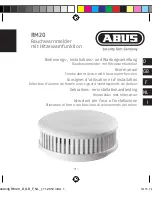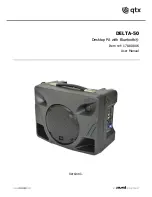
15
EN
ENGLISH
IMPORTANT: When placing the meat probe into your meat, ensure the meat probe and meat probe wires avoid
direct contact with flame or excess heat. This can result in damage to your meat probe. Run the excess wire out the
front main cabinet door, along the edge. When not in use, disconnect from the meat probe connection port, and
place aside to keep it protected and clean.
HOPPER PRIMING PROCEDURE
These instructions should be followed the first time the smoker is ignited, and each time the smoker runs out of pellets in the
hopper. The auger must be primed to allow pellets to travel through the length of the auger, and fill the burn pot. If not primed,
the igniter will timeout before the pellets are ignited. Follow these steps to prime:
1. Open the hopper lid. Make sure there are no foreign objects in the hopper or blocking the auger feed system at the bottom.
2. Remove all cooking components from the interior of the smoker. Locate the burn pot in the bottom of the smoke cabinet.
3. Plug the power cord into a power source. Press the
Power Button
to turn the unit ON, and turn the
Temperature
Control Dial
to the SMOKE position. Check the following items:
• That you can hear the auger turning. Place your hand above the burn pot and feel for air movement. Do not place
your hand or fingers inside the burn pot. This can cause injury.
• After approximately a minute, you should smell the igniter burning and begin to feel the air getting warmer in the
burn pot. The igniter tip does not glow red hot. Do not touch the igniter. This item gets extremely hot and will burn.
4. Once verified that all electric components are working correctly, press and hold the
Power Button
to turn the unit OFF.
5. Fill the hopper with all natural barbecue wood pellets. Monitor the pellet level using the sight-glass along the side.
6. Press the
Power Button
to turn the unit ON. Turn the
Temperature Control Dial
to the SMOKE position. Press and hold
the
Prime Button
until you see pellets entering the burn pot from the auger tube. Once pellets begin to drop into the
burn pot, release the
Prime Button
. Allow the pellets to ignite and create flame. Once flames are coming out of the burn
pot, press and hold the
Power Button
to turn the control board OFF, and let the smoker cool down.
7. After the smoker has cooled, re-install the cooking components into the main cabinet. The smoker is now ready to use.
FIRST USE – SMOKER BURN-OFF
Once your hopper has been primed and before using your smoker for the first time with food, it is important to complete a burn-
off. Start the smoker and operate at any temperature over (177°C / 350°F) with the cabinet door closed for 30 to 40 minutes to
burn-off the unit and rid it of any foreign matter.
AUTOMATIC START-UP PROCEDURE
1. Ensure the
Temperature Control Dial
is in the SMOKE position. Plug the power cord into a grounded power source.
2. Check the burn pot to ensure there is no obstruction for proper ignition. Open the hopper lid. Ensure there are no foreign
objects in the hopper or auger feed system entry at the bottom of the cabinet. Fill or top-up the hopper with dry, all
natural barbecue hardwood pellets. Fill the water pan ¾ with water, and monitor during your cook; re-fill frequently.
3. Press the
Power Button
to turn the unit on. This will activate the start-up cycle. The auger feed system will begin to
turn, the igniter will begin to glow and the fan will supply air to the burn pot. The smoker will begin to produce smoke
while the start-up cycle is taking place. The cabinet door must remain open during the start-up cycle. To confirm the
start-up cycle has begun properly, listen for a torchy roar, and notice some heat being produced.
4. Close the cabinet door. Turn the
Temperature Control Dial
to 177°C / 350°F, to allow the unit to preheat for approximately
15 to 20 minutes.
5. After preheating is complete, you are ready to enjoy your smoker at your desired temperature!
IMPORTANT: When selecting SMOKE or a low temperature setting after preheating, the auger will continue to
turn and feed pellets. This will momentarily raise the temperature, but temperature will eventually decrease and
stabilize. Remember that you are trying to regulate a fire, so time is necessary to achieve your desired temperature.
















































